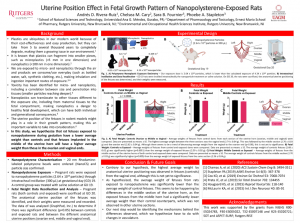Rivera-Ruiz, Andrés: Uterine Position Effect in Fetal Growth Pattern of Nanopolysterene-Exposed Rats
Title: Uterine Position Effect in Fetal Growth Pattern of Nanopolysterene-Exposed Rats
Name: Andrés Rivera-Ruiz
Home Institute: Universidad Ana G. Méndez, Gurabo Campus
Programs: RISE program, Summer Undergraduate Research Fellowship (SURF) at Ernest Mario School of Pharmacy
Other contributors: Chelsea M. Cary, Dr. Sara B. Fournier, Dr. Phoebe A. Stapleton
Abstract: Plastics are everywhere around us. When disposed, these ubiquitous products are unable to degrade completely, instead fragmenting into smaller pieces, producing micro- and even smaller nanoplastics. It has been shown that the average woman inhales an average of 132 microplastics daily. Previous studies have shown that nanoplastics are significantly more toxic than larger microparticles after inhalation. Unfortunately, studies evaluating fetal health after maternal nanoplastic exposures are limited. In this study, we assessed rat fetal growth, while taking into consideration the anatomical uterine positioning of fetal implantation (ovarian, middle, and vaginal thirds) within the uterine horn after maternal pulmonary exposure to nanopolysterene particles (NP) late in gestation. We hypothesize that rat fetuses exposed to NP during gestation have a lower average weight than controls and that fetuses implanted in the middle of the uterine horn will have a higher average weight than those in the ovarian/vaginal ends. Pregnant rats (n=9-12) were exposed to NP through intratracheal instillation at gestational day (GD) 19 and sacrificed on GD 20, along with a sterile saline control group. The anatomical uterine positioning of the fetuses within the uterus was identified, and weights were measured and recorded. Preliminary data indicates pups from exposed dams were significantly smaller than control (2.59±0.02g vs. 2.68±0.02g, respectively). This outcome was driven by pups in the middle of the uteri wherein exposed pups were significantly smaller than control (2.56±0.03g vs. 2.70±0.03g, respectively). Interestingly, fetuses in the vaginal end have the highest average weight in either the control or exposed group from the positions analyzed although this is not to significance. The results found in this study further expand our knowledge on the developmental toxicity of nanoplastics and help to achieve more accurate conclusions from reproductive toxicological studies that utilize rodent models. Supported by NIEHS R00-ES024783, P30-ES005022, T32-ES007148, R25-ES020721, SOT and ASPET-SURF.
Biography: I am Andrés D. Rivera Ruiz, a rising senior in Chemistry at Universidad Ana G. Méndez, Gurabo Campus in Puerto Rico. I have been doing research on materials science at my home institution since my freshman year, where under the mentorship of Dr. Ileana González, have been looking into ways of optimizing alkaline fuel cells through the use of ammonia and platinum nanoparticles. On the summer of 2019, I was part of the Bridge to Ph.D. in Neuroscience Program at Michigan State University, where under the mentorship of Dr. John J. LaPres, studied a possible crosstalk between the aryl hydrocarbon receptor (AhR) and the translocator protein (TSPO) that could modulate the electron transport chain efficiency. After finishing my undergraduate studies, I look forward to pursuing a Ph.D. in biomedical sciences, more specifically in the fields of immunology, toxicology and/or developmental biology. Apart from research, I enjoy learning about science communication and other languages, reading, and listening to music. I am grateful for the RISE and SURF programs for giving me this research opportunity despite the current circumstances.
